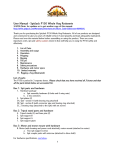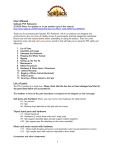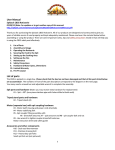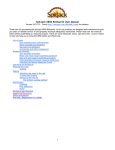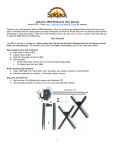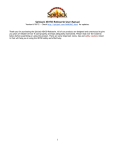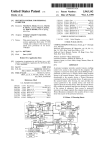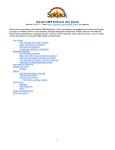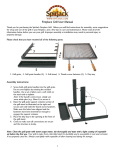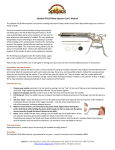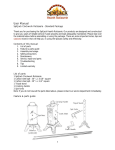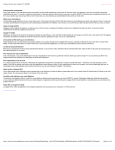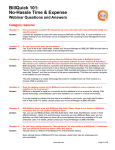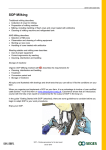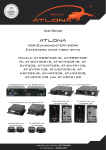Download User Manual SpitJack P80 Rotisserie
Transcript
User Manual SpitJack P80 Rotisserie 7/17/09 (Note: for updates or to get another copy of this manual: http://www.spitjack.com/Merchant2/merchant.mvc?Store_Code=SJ&Screen=MANUAL Thank you for purchasing the SpitJack P80 Rotisserie. All of our products are designed and constructed to give you years of reliable service if used properly and kept adequately maintained. Please read over the material below before assembling or using the product. There are some important notes, tips and safety cautions mixed in that will help you in using the P80 safely and effectively. 1. List of Parts 2. Assembly and usage 3. Operation 4. Prepping 5. Rigging 6. The pit 7. Maintenance 8. Safety precautions 9. Hardware and motor specs 10. Limited warranty 11. Rigging a hog (illustrated) 12. Firepit Layout List of parts The P80 is packed in a single box. Please check that the box has not been damaged and that all the parts listed below are accounted for. Spit parts and hardware 1. Hardware package (Note: you may receive extra hardware for replacement) a. Spit assembly hardware (4 socket head bolts and 4 wing nuts) b. 2 sizes of small socket head screws c. 3 sizes of hex wrenches 2. Spit plate (1) 3A. Spit - section A (with bearing ring attached) 3B. Spit - section B (with connector pipe and bearing ring attached) 3C. 2 bearing rings (attached to the spit) with set screws Tripod stand parts and hardware 4. Tripod stands (2) 5. Spit support assembly A (pipe and spit support welded together) 6. Spit support pipe B (for attaching to the motor assembly) Motor and motor mount with hardware 8. Motor (with housing and power cord attached), motor mount (attached to motor) a. Spit support already mounted b. Spit coupler parts with setscrew (attached to drive shaft) 1 For hardware specifications, see below. Accessories and other components There are many accessories that you can order separately for your P80. If you have ordered them with the P80, they may be included in one of the boxes (but not pictured below) or come in a separate package. 2 Rotisserie Assembly The P80 requires some minor assembly before its first use. Before you begin the assembly procedure, check to make sure you have all the parts, tools, and necessary hardware at hand. Spit assembly procedure: 1. Slide spit section A into spit section B 2. Set spit plate alongside the spit evenly at its center and adjust so that the 4 centered holes in the plates match up with the hole in the spit. 3. Push each of the 4 stainless bolts through spit plate and the spit and fasten each securely with a stainless wing nut using the largest Allen wrench. Fully Assembled spit (center section) 4. The bearing rings are installed on the spit at the factory. Note that ends of each spit section are machined down to accommodate the bearing rings. Note 1: If you will be putting the spit through the “natural openings” at either end of the hog you will need to remove one of the bearing rings to do so. Using the smallest wrench provided, unscrew the setscrews on the outside of the bearing rings and slip the ring off the spit. Reverse the procedure to reattach the ring when the hog has been rigged to the spit. Note 2: The bearing ring housing material and the setscrews are not stainless. In order to prevent rust spots and pitting, coat with vegetable or mineral oil after each use and before prolonged storage. Motor and motor mount assembly procedure: The motor comes fully mounted with spit coupler and spit support attached. Check to see that the spit coupler set screw and the spit support screws are tight and that there is sufficient space between the coupler and the motor mount so that the motor shaft can turn freely. Tripods and spit supports assembly procedure: 1. Remove the screws from the top of the bases. Place the spit support pipes A & B through the tripod bases. Adjust the height of each pipe and replace the screws and wing nuts to secure the support pipes. Note: make sure both pipes are set at the same height. 3 Base and pipe assembly B (Ready to accept the motor mount assembly) Support pipe A fastened into tripod base 2. Place the motor mount assembly in the spit support pipe assembly B (above). Note that there is a notch in the motor mount base connector pipe that must be aligned properly with the cross screw in the support pipe that it sits in (below). If these are connected properly, the base will be positioned (one leg will be directly under the motor assembly and in parallel alignment) so as to prevent the motor and base assembly from tipping over. Make sure that the motor mount assembly pipe (with notch) is fully seated in the pipe and that the alignment with the base is correct (see picture below). Cross screw in support pipe (top view) Motor mount assembly showing notch on connector Alignment of motor (top view) Final assembly procedure: Note: at this point you would most likely have rigged the hog to the spit (see below). 1. Set the spit up so that it is resting on both supports, with the bearing rings seated into the spit supports. 2. Place one end of the spit in the spit coupler (attached to the driveshaft of the motor) and secure it with the screw provided. Push the screw through the coupler and the spit and secure tightly with the wing nut. Spit seated on support (1) 4 Spit attachment to spit coupler detail (side view) Spit attachment detail (top view) 3. Check to make sure all connections are tight and secure. Attaching the Manual Operation Wheel (an optional accessory not included in the standard package): 1. Attach the handle to the wheel by fastening it through the wheel plate with the screw and bolt provided. 2. Slide the wheel onto the end of the spit, flange end first, and adjust so that the holes in the spit and the wheel line up. Insert the setscrew provided and secure tightly with the wing nut. Note: When using the manual operation wheel, you will be using the spit coupler screw as your set pin. This is designed so that the spit cannot be turned accidentally from the motor while in manual operation (this could damage the motor and spit assembly) 3. Using the spit coupler screw set the spit at the position you like and secure by pushing the screw through the wheel plate into the spit support pipe. 4. When you need to rotate the spit, remove the setscrew, set a new position using the handle to turn the spit assembly and reset the screw. Completed P80 assembly (with optional Manual Operation Wheel) 5 Operating the Rotisserie Once the rotisserie has been fully assembled, all the screws and bolts are checked for tightness and proper adjustment, the loaded spit has been attached as instructed above, the drip pan is in place, the fire pit has been constructed and the fire is underway, simply attach a (connected) properly rated and sized extension cord to the power cord of the motor and the motor will automatically start. Check to see that the spit is turning smoothly and motor is running without and unusual noises. To shut off the motor, disconnect the power source. Tip: attach a switched surge protector between the motor power cord and the extension cord for surge protection and to make turning the motor on and off much easier. Prepping the hog It’s a good idea to hose (or even scrub) the hog down thoroughly and dry it before you begin. Then, give it a good rubbing, inside and out with salt. If you have to store it for any longer than a few hours, ice it up as best you can and store in a cool, safe place until ready to cook (this can be done after the rigging). As far as any culinary preparations, there are of course endless options. Some of the most common are injecting with a flavor solution or marinade (the meat of the hog will not pick up much ambient flavor such as smoke or even surface seasoning that is applied) and brining. Since it’s not very easy to brine a large hog, flavor injection is more popular. You can inject up to 12 hours before cooking. Stuffing it Since the hog will cook for many hours and end with a high internal temperature, you can stow just about anything (pork buts, turkeys, sausages, etc.) in the belly and it will cook through. Stuffing should be done after the hog is rigged to the spit (see below). Rigging Attaching the meat to the spit: Just as there is no standard way to cook a whole hog, there is no standard way to rig the hog for cooking, and there are probably as many variations as there are cooks. For use with this machine we recommend a specific method of securing the hog to the spit that will keep the hog from loosening on the spit all throughout the cooking. Instead of using forks at each end (this technique is more practical for solid pieces of meat such as a roast) we recommend “lashing” the backbone of the hog directly to the spit by stitching it with butchers twine and a special trussing needle. A detailed guide on how to do this can be found on our web site. Note: this process can easily take two hours. Try to have someone helping you and plan the timing accordingly. Remember it will take at least 12 hours to cook a 150 lb. hog so you may want to consider rigging the night before if you plan an all-day cook. Trussing and binding: The other thing to consider is how to keep the hog intact until the end of cooking. Because of the size of the animal (the larger the hog, the bigger this problem), the prolonged cooking times, and the condition of the meat when fully cooked, some parts of the hog my come loose toward the end of cooking. Because the meat gets soft, some shrinkage occurs, connective tissue is broken down, so the cooked animal may start to loose it’s “integrity”. In other words, unless properly held together, parts of the animal may become dislodged and actually fall off. 6 To address this, some people wrap the hog in chicken wire to form a crude cage and sometimes even tighten the apparatus as needed during the cooking. This is can be cumbersome and unhealthy (most chicken wire is treated with a poisonous zinc compound). We suggest both trussing the whole length of the hog at intervals with butcher’s twine and using over-sized worm gear hose clamps (available at http://spitjack.com) on the fore and hindquarters as a backup. It’s also a good idea to sew up the belly, even if it’s empty, to make the cooking easier. For a detailed illustrated tutorial on rigging your hog, see blow or click here. Setting up the fire pit There are many different ways to configure a pit for use with this rotisserie. The method below is one that we have tested successfully and which addresses most issues that come when cooking a whole hog in this way. This machine is designed to use directly on the ground or floor surface. Make sure you have a level, hard, non-flammable surface at least 10’ x 4’ to use for the operation. If there is anything you want to protect in this space (such as patio tiles or a lawn) we suggest laying down sheet metal as a protective base (a 4’ x 8’ sheet is perfect for this). The indirect cooking method Although it may seem illogical, it is best not to cook the hog directly over the fire. The main reason for this is that when fat starts rendering and dripping onto a hot coal, it may cause a flare up. It is also possible for fat to heat up to a high temperature without dripping out and a flare up can cause the whole hog to ignite. Either way, unwanted flare-ups are to be avoided if possible and the best way to accomplish this is by not cooking directly over the heat source. On the other hand, you want to get as close as possible to the heat or else the hog will take too long to cook. We recommend a drip pan directly under the animal to catch drippings (of fat and juices) and a fire of charcoal or hot hardwood embers as close as possible to the turning meat. This will be different with every pit configuration, but the principal is the same; 1. Consider the drippings and the danger of flare-ups 2. Have a drip pan (or sand pile) directly underneath the meat to catch the drippings 3. Have the fire as close to meat as possible while still considering the above. 4. Have the meat as close to the heat as possible by adjusting the height of the spit. Using these guidelines, we have cooked a hog in 40 degree (F) ambient temperature on a windy day to 195 degrees in normal cooking time. Maintenance Care of the SpitJack P80 is simple and inexpensive but should be done regularly to insure maximizing the product life. Cleaning Before the first use and after extended storage: 1. Clean the entire spit assembly (inside and out) with warm soapy water, rinse and dry thoroughly. Coat the spit bearing rings and spit connector pipe lightly with vegetable or other food-safe oil. 2. Wipe off any excel oil, dirt or residual packaging from the rest to the parts. After each use and before extended storage: 7 1. Clean the entire spit assembly (inside and out) with warm soapy water, rinse and dry thoroughly. Coat the spit bearing rings and spit connector pipe lightly with vegetable or other food-safe oil. 2. Wipe down or wash other parts as needed. Dry and touch up with heat safe paint if needed. Store in a dry place until nest use. Cover the motor assembly if possible to prevent dust and dirt accumulation. Rust protection Keeping certain parts lubricated (lightly coated with oil or other anti-corrosive material) or touching up paint scrapes or chips will prevent premature rust and corrosion. 1. The spit bearing rings. These are not stainless steel (although they are highly polished) and needs to be coated after each use and cleaning to prevent rusting and pitting. 2. The spit connector pipe is blackened steel and needs to be coated after each use and cleaning to prevent rusting and pitting. 3. Touch up any paint chipping or scratches with high heat black paint (usually made for stoves or BBQ grills). Motor The P80 motor is well-built, rugged component that will last years if properly used and maintained. 1. Try not to expose it to too much dust or dirt while in use and keep it as dry as possible. 2. Keep it as dry as possible. 3. Occasionally oil the drive shaft with some 10W-40. Hardware specifications: If you need to order hardware for your P80 either call us or ask for the following at your local parts dealer or online (key: diameter, length (mm), thread pitch): 1. Bearing ring setscrews (4) – M4 10 70 (stainless) 2. Spit coupler setscrew (1) – M4 16 70 (stainless) 3. Spit support-motor mount screws (2) M8 26 1.25 (stainless) 4. Spit coupler screw (1) M8 80 1.25 (stainless) 5. Spit coupler screw wing nut (1) (stainless) 6. Spit plate assembly screws (6) M8 70 1.25 (stainless) 7. Spit plate assembly wing nuts (6) (stainless) 8. Motor housing – motor mount screws (4) M8 ?? 1.25 9. Hex wrench – large M6 10. Hex wrench small M3 Motor specifications: Voltage: Motor type: RPM: Phase: Shaft Speed: Continuous torque: Operating temperature range: Overall Dimensions: Base tripods – 15” diameter footprint Length fully assembled (base to base) - 78”, end of spit (or manual wheel) to end of motor – 74” Spit height - adjustable from 16” to 21” (from middle of spit to ground) Spit length – 66” total, 54” usable (between base legs) 8 Safety precautions: The SpitJack P80 is a powerful machine with electrical components that will be used outdoors in conjunction with live fire and high heat and safety awareness and proper safety procedures should be followed at all times while in use. Electrical hazard: 1. Make sure any extension cord you use is properly grounded, rated for this use, and in sound condition. 2. Keep all electric cordage (whether the cord or plug from the P80 motor or any extension that is connected) away from the direct heat source (fire, hot coals, or any part that has gotten very hot. 3. Keep all electric cordage (whether the cord or plug from the P80 motor or any extension that is connected) away from water. Make sure any extension cords are not in any collected water. Do not operate the P80 in rain or snow unless all parts and connections are kept dry. 4. Do not attempt to modify or repair the motor while it is running. 5. Disconnect the power immediately if any unusual sound or odors or smoke are coming from the motor. Fire, heat and burn hazard: Since you will need a large heat source to use the P80, special precautions must be taken to prevent harm to yourself, other people, the environment, property, and the equipment. 1. Make sure you have properly prepared your “pit” area where the fuel will be burned. There should be not be any easily combustible material either directly under the burning area or in nearby proximity. Keep all combustible material a safe distance from the fire at all times. 2. Use only appropriate fuel sources (wood logs, natural or other charcoal products) for your heat source. Use only approved starter fluid (or other methods) to start the fire only. Do not add starter fluid, gasoline or any other highly flammable material to the fire once it has started. 3. Tend the fire continuously and carefully. Never leave sight of the live fire. Do not add more fuel than needed. 4. Be aware of fat dripping from the cooking meat. Hot fat can easily ignite if it comes in contact with a live flame. If you have a fat collection device or system, make sure collected or excess fat is removed periodically and not let to sit hot by the heat. 5. Do not wear very loose fitted clothing such as a long dress or robe while tending the fire. 6. Keep a properly rated and sized fire extinguisher handy for emergency use. 7. Take care when handling any part of the P80 or anything that has been close to the heat source. Mechanical hazard: The P80 is a very powerful machine and can cause bodily harm or injury unless used safely and according to instructions. 1. Make sure the power is disconnected before assembly, disassembly, or maintenance. 2. Some of the components of the P80 are heavy. Use proper lifting and transport procedure while handling. 3. Do not overload the motor. This machine is rated and tested at no more than 200 lbs. on the spit. Any additional weight may case excess wear on the motor or motor malfunction. 9 Limited Warranty LIMITED WARRANTY. Rasa Incorporated, d/b/a/ SpitJack (the “Company”) warrants that (a) its SpitJack (the “Product”) will perform substantially in accordance with the accompanying written materials for a period of one year from the date of receipt and (b) that the components of the Product is contained will be free from defects in materials and workmanship under normal use and service for a period of one (1) year. In the event applicable law imposes any implied warranties, the implied warranty period is limited to one year (365 days) from the date of receipt. Some jurisdictions do not allow such limitations on duration of an implied warranty, so the above limitation may not apply to you. . This warranty is valid only for Product (s) purchased directly from SpitJack or from one of its authorized dealers. CUSTOMER REMEDIES. The Company’s and its suppliers’ entire liability and your exclusive remedy shall be, at the Company’s option, either (a) return of the price paid for the Product, or (b) repair or replacement of the Product that does not meet this Limited Warranty and which is returned to the Company with a copy of your receipt. This Limited Warranty is void if failure of the Product has resulted from accident, abuse, or misapplication. Any replacement Product will be warranted for the remainder of the original warranty period or thirty (30) days, whichever is longer. NO OTHER WARRANTIES. TO THE MAXIMUM EXTENT PERMITTED BY APPLICABLE LAW, THE COMPANY AND ITS SUPPLIERS DISCLAIM ALL OTHER WARRANTIES, EITHER EXPRESS OR IMPLIED, INCLUDING, BUT NOT LIMITED TO IMPLIED WARRANTIES OF MERCHANTABILITY AND FITNESS FOR A PARTICULAR PURPOSE, WITH REGARD TO THE PRODUCT AND ANY RELATED OR ACCOMPANYING WRITTEN MATERIALS. THIS LIMITED WARRANTY GIVES YOU SPECIFIC LEGAL RIGHTS. YOU MAY HAVE OTHER RIGHTS WHICH VARY FROM JURISDICTION TO JURISDICTION. NO LIABILITY FOR DAMAGES. TO THE MAXIMUM EXTENT PERMITTED BY APPLICABLE LAW, IN NO EVENT SHALL THE COMPANY OR ITS SUPPLIERS BE LIABLE FOR ANY DAMAGES WHATSOEVER (INCLUDING WITHOUT LIMITATION, SPECIAL, INCIDENTAL, CONSEQUENTIAL, OR INDIRECT DAMAGES FOR PERSONAL INJURY, LOSS OF BUSINESS PROFITS, BUSINESS INTERRUPTION, LOSS OF BUSINESS INFORMATION, OR ANY OTHER PECUNIARY LOSS) ARISING OUT OF THE USE OF OR INABILITY TO USE THIS PRODUCT, EVEN IF THE COMPANY HAS BEEN ADVISED OF THE POSSIBILITY OF SUCH DAMAGES. IN ANY CASE, THE COMPANY’S AND ITS SUPPLIERS’ ENTIRE LIABILITY UNDER ANY PROVISION OF THIS AGREEMENT SHALL BE LIMITED TO THE AMOUNT ACTUALLY PAID BY YOU FOR THE PRODUCT. BECAUSE SOME JURISDICTIONS DO NOT ALLOW THE EXCLUSION OR LIMITATION OF LIABILITY FOR CONSEQUENTIAL OR INCIDENTAL DAMAGES, THE ABOVE LIMITATION MAY NOT APPLY TO YOU. © SpitJack 2006-7. All rights reserved 10 Rigging the hog to the spit: (These pictures reprinted with permission form Richard Sarich, creator of the BBQ1 Whole Hog Rotisserie system) Step 1: Support your spit on both ends, about sixteen inches off of a clean work surface. This will give you enough room to work on both sides of the spit. Slide/lay your choice of meat across the spit. If you're cooking a whole hog, slide the spit through the mouth. Cut several twenty-four inch lengths of butcher twine, which will be used to attach the meat to the spit. Step 2: Insert the trussing needle through the back of the meat, in-between the ribs, and and alongside of the spit. Insert about six inches of the double-over twine in the tip hole of the trussing needle. Pull the needle with twine slowly back through the meat leaving one end of the twine loose on top. 11 Step 3: Continue by bringing the trussing needle and twine back up through the other side of the spit, ending up with both ends of the butcher twine on top and looped around the spit. Step 4: Pull both ends tight while tying a triple knot, securing the meat tightly to the spit. Cut any excess twine leaving about an inch from the knot. 12 Step 5: Repeat these steps every six inches, from one end of the meat to the other, until you have fully secured the meat to the spit. Step 6: Give special attention to the head and legs making sure all parts are secured. Make sure to pull both ends tight, allowing for the shrinkage that will occur during cooking. 13 Step 7: When you have fully secured the meat to the spit, rotate the spit one half of a turn, revealing the open cavity toward you. Now is the time you can add any seasonings to the inside of the cavity. When all seasonings and fillings are in place, using the trussing needle and a long piece of twine you can start sewing up the cavity. Step 8: Sliding the needle all the way through both sides of the meat and pulling the twine back through works the best. Complete the procedure, closing the entire cavity. With your coals hot you're ready to start cooking. Remember the key to great rotisserie cooking is LOW and SLOW. This means keep the coals low, maintaining a steady heat which will cook the meat slow, taking advantage of the rotation of the machine. This will tenderize the meat to it's fullest capacity. 14 Firepit Layout Below are illustrations of how a firepit can be constructed from simple building materials. The green area is the ground, the gray is a sheet metal panel and the red is standard bricks and border edging available at Home Depot. The drip pan directly under the spit is not yet in production. 15 Material List and Instructions for a Brick Pit for the P150 Rotisserie From The Home Depot (similar products are available through other sources) you will need: 60 of these concrete pavers (bricks) in either style: 1.75 In. x 4 In. Holland 45MM Paver - Red Model 22051EA http://www.homedepot.com/webapp/wcs/stores/servlet/ProductDisplay?storeI d=10051&langId=1&catalogId=10053&productId=100619492&categoryID=502344 or… 1.75 In. x 4 In. Holland 45 MM Paver - Red / Charcoal Model 22088EA http://www.homedepot.com/webapp/wcs/stores/servlet/ProductDisplay?sto reId=10051&langId=1&catalogId=10053&productId=100619494&categoryID=502344 and, 16 of these landscape edging bricks: 12 In. Straight Picket Red Model 75951 http://www.homedepot.com/webapp/wcs/stores/servlet/ProductDisplay?sto reId=10051&langId=1&catalogId=10053&productId=100145487&N=10000003+502055+90039 &marketID=90039&locStoreNum=2684 Pattern suggestion for pit floor layout: Place edging blocks around the pattern on all sides. 16 Pork Injection Marinade (3 variations) 3/4 cup apple juice 1/2 cup water 1/2 cup sugar 1/4 cup kosher salt finely ground 2 tablespoons Worcestershire Dizzy Pig: 2 c apple juice ½ c cider vinegar ¼ c Worcestershire 1 cup sugar 2 TBS rub (ground fine) SpitJack: 1 ½ cups apple juice 1 cup apple cider vinegar 2 tablespoons Worcestershire sauce ½ cup sugar 2 Tablespoons salt 2 Tablespoons powdered (in a coffee grinder) rub (of your choice) or 2 more tablespoons salt Optional: hot sauce (e.g. Frank’s) Heat the apple juice and add the salt, rub and sugar. When dissolved, add the remaining ingredients. Cool. © SpitJack 2006-2009. All rights reserved 17 Securing a Whole Animal to the SpitJack 150 or P80 Spit A user’s instruction sheet for trussing hardware and equipment This document is updated periodically. For the latest version go to web address: http://www.spitjack.com/Merchant2/merchant.mvc?Store_Code=SJ&Screen=MANUAL Securing the animal to the spit is a critical part of the rotisserie cooking process. If not done properly and sufficiently, your entire event may be susceptible to failure. Since the rotisserie will be turning at a constant rate of 4 RPM and you have a relatively heavy, unbalanced load, there are considerable forces that you must reckon with to insure your success. Using the appropriate hardware and accessories are essential to this process. Each event is different both in type and weight of animal, slaughtering methods and final preparation so it is virtually impossible to prescribe just one method, hardware set or piece of specialty equipment. Our answer is to provide you with many different tools and equipment so you can adapt to the specific needs of your event. Basic concepts and tips: 1. Skewering vs. Securing. The simple idea of “skewering” meat with a spit is best suited to solid pieces of meat like roasts. The whole animal is a hollow object, not a solid piece of meat. Because of this, a different approach is taken. The animal must somehow be firmly connected to (or engaged with) the spit. While another popular concept- large “spit forks” that are bolted to the spit and then stuck into the meat- have some value, they are rarely sufficient to do the job, especially on larger animals. The best way to assure the animal will stay connected to the spit throughout the entire cooking process is by bringing the spit and the animal’s backbone into play. By either stitching with twine, wire, or by using other hardware a strong “tightenable” connection between the spit and the backbone is the best way to avoid the meat “flopping” during the cooking. Method 1: Trussing with a needle and butcher’s twine This method uses a special long needle and butcher’s twine to basically stitch the animal onto the spit (see instructions of the website: (http://www.spitjack.com/Merchant2/merchant.mvc?Store_Code=SJ&Screen=TRUSS) or in the user manuals. This method is all that is needed for most animals under 50 lbs. The drawback to this technique is that if the stitches loosen, there is no easy way to tighten them. Also, this alone is not sufficient for larger animals. Method 2: Banding with oversized hose clamps These can be used in one of 3 ways: 1) as a way to lash the legs of the animal either together or to the spit or both, 2) as a “stitch” as in the method described above, or 3) as a way to keep the meat intact by banding it around the animal, usually at the key heavy parts (legs, shoulders). This provides an alternative to chicken wire wrapping which may leech poisonous chemicals (if galvanized) into the meat. These clamps can be tightened as needed with a simple screwdriver throughout the cooking process. Method 3: External spit forks External forks are what most people associate with spit binding. They slide onto the spit and the fork tines enter the meat before the fork is tightened on the spit. This can be done at either or both ends (although not practical if the head of the animal is still on). While this method seems natural, it has its drawbacks when cooking whole animals. It is better suited for solid pieces of 18 uniform size meat that are cooked more quickly. When used on a whole animal, it may be hard to engage the tines effectively and if you are able to, they may start to loosen (and are not able to be adjusted or tightened) as the meat softens toward the end of cooking. Method 4: Spit pins (see photo illustrations below) This method uses a specialized spit pin made of stainless threaded rod (long bolt actually) with washers and wing nuts at each end. The pin is jammed (or power driven) though the animal (usually at the heaviest concentration of meat such as the legs, hips or shoulders), through the spit, and out through the meat again. The wing nuts at each end can then be easily tightened as needed. Oversize washers prevent the wing nuts from digging too far into the meat. By utilizing the holes in the spit the “pin” method brings the spit into play to help move the largest parts of the animal. The drawback of this technique is that the backbone is not used and if the meat becomes soft enough, they could lose their effectiveness (not likely). Pins can also be used to secure the head to the spit or bind the feet together, etc. Method 5: Internal spit forks (I-fork) (see photo illustrations below) Internal forks are very effective in binding the meat to the spit and preventing “flopping” of the heavier sections of the animal during cooking. They use the best design concepts of some other methods and provide the most reliable way of securing larger (100 lbs. or more) animals. The Ifork is bolted though the spit and threaded spit pins are then driven up through the meat and protrude on either side of the backbone. They are then secured with a common plate and tightened with wing nuts. The plate can then be easily tightened down as needed throughout the cooking. 19 Spit Pin instructions: 1. Set up the spit pin as illustrated above 2. Make sure you have the spit oriented so that the hole is facing the proper direction to receive the pin. Push pin through one side of the meat, through the hole in the spit, and then out the other side of the meat. You can use a 9/16” socket wrench (hand or power) to help if you need to. The pin should now look like it does in the photo above. 3. Place the second washer and wing nut on the open end and tighten down as needed. 20 Internal Fork (I-fork) Instructions 1. Disassemble the I-fork so it appears as in the photo above. Note: you may have a different “center bolt” or have received no bolt at all. Just use one of the spit bolts that came with your P55L or P150. 2. Make sure the spit and meat are oriented properly to receive the I-fork correctly. The hole in the spit should be facing upwards and be located in line where you want to fasten the meat. Place the “U plate” (being held above) on the spit so that the holes line up. The U-plate should be facing down into the meat (below) 3. Slip spit bolt through the spit and the U plate from the underside and secure with the wing nut. 21 4. Set the pins as shown below. 5. Drive the pins all the way through using a 9/16” socket wrench (hand or power). 6. Turn the spit over 180 degrees so the pins are exposed as above. 7. Place the top plate over the pins and screw on the wings nuts. 8. Tighten the wing nuts down to the plate and adjust as needed throughout cooking. © SpitJack 2004-2009. All rights reserved. 22






















